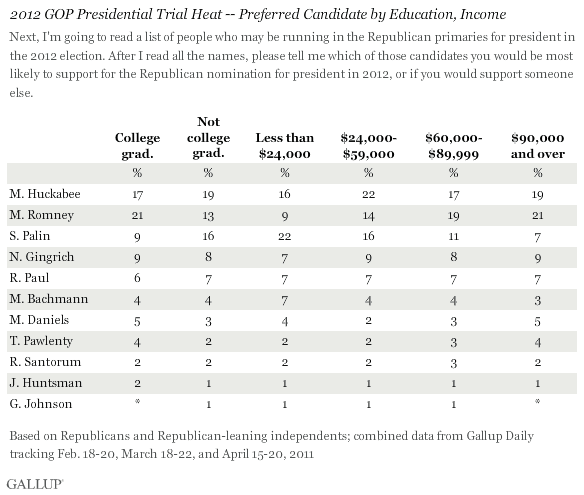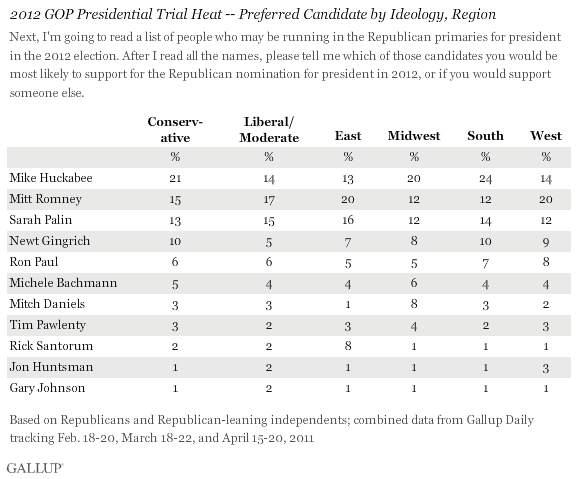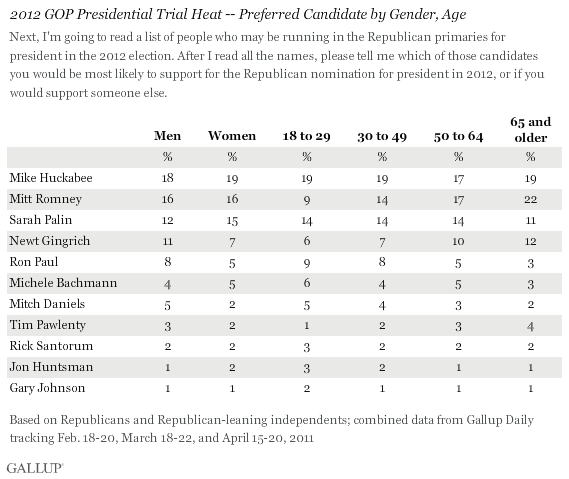PRINCETON, NJ -- Republican college degree holders are more likely than those without a degree to support Mitt Romney for the Republican presidential nomination in 2012, 21% vs. 13%. Similarly, Romney's support climbs from 9% of Republicans earning less than $24,000 annually to 21% of those earning $90,000 or more. The reverse is true for Sarah Palin, who is favored by nearly twice as many Republicans without a college degree as those with one, 16% vs. 9%, and her support decreases by income from 22% among the lowest income group to 7% among the highest.

These findings are based on the 2012 Republican primary preferences of 3,304 Republicans (including independents who lean Republican) across three national Gallup surveys conducted in February, March, and April as part of Gallup Daily tracking. The combined data do not include support for Donald Trump, given that he was not included in Gallup's trial heat surveys in February or March. Trump tied Huckabee for first with 16% support in the April poll, but for this analysis, that 16% is reapportioned to the candidates who were his voters' second choice.
Huckabee, who has either ranked first or tied for first in all three surveys since February, does not spark strong socioeconomic differences in Republicans' support, nor do Newt Gingrich or Ron Paul.
Support for other candidates included in Gallup polling, including Michele Bachmann, Mitch Daniels, and Tim Pawlenty, is in the low single digits, a level at which demographic distinctions are less meaningful.
Huckabee's Support Tilts to the Right, Politically; to the South, Geographically
At the same time that Huckabee receives similar levels of support from Republicans of different education and income levels, he does decidedly better among Republicans in the South (24%) and Midwest (20%) than among those in the East (13%) and West (14%). He also does much better among conservative than among liberal or moderate Republicans, 21% vs. 14%.
By contrast, Romney fares best in the East (20%) and West (20%) -- topping Huckabee in these regions. Liberal/Moderate and conservative Republicans support him to similar degrees.

Despite her strong Tea Party connections, Palin receives as much support from liberal/moderate Republicans as she does from conservative Republicans, 15% vs. 13%. Also, there is little differentiation in preferences for her by region, ranging from 12% in the West and Midwest to 14% in the South and 16% in the East.
Gingrich does twice as well with conservatives as with liberals and moderates, 10% vs. 5%. However, he is preferred by similar percentages of Republicans across regions, from 7% to 10%.
None of these upper-tier contenders for the nomination has formally announced his or her candidacy for the 2012 nomination, and none appeared in the first presidential debate, co-hosted last week by the South Carolina Republican Party and Fox News. Among those who did participate, Paul earns as much support from conservative Republicans as from moderate/liberal Republicans, at 6%, and hovers around this level in each region.
Additionally, when one looks at four broad age groups within the ranks of Republicans and Republican leaners, both Romney and Gingrich have greater support among older than younger Republicans. Conversely, Paul does best among younger Republicans, his support dwindling from 9% of 18- to 29-year-olds to 3% of those 65 and older.
The preferences of Republican men and women are generally similar; however, Gingrich receives slightly higher support from men than from women, 11% vs. 7%.

Bottom Line
As potential Republican candidates attempt to build national support while simultaneously focusing on the early primary states, they need to appeal to different elements within the party -- men and women, young and old, wealthy and not wealthy, Easterners and Southerners, and more.
None of the leading candidates at this stage is without some limitation in terms of earning widespread support. While Huckabee's support crosses socioeconomic lines, it is heavily concentrated among conservatives and in the South and Midwest. Romney, while competitive among the ideological groups, does not thus far enjoy strong support among working-class Republicans; rather, he appeals particularly to upscale Republicans. Palin has the opposite pattern, appealing to middle to lower socioeconomic households far more than upper-income and more educated households. At the same time, her appeal is fairly uniform across regions and by ideology.
Too few Republicans currently support Gingrich, Paul, Bachmann, Pawlenty, and others for these demographic distinctions to yet matter. However, as the candidates work to become better known, their respective images may skew toward one group or region or another. Those patterns will become apparent in Gallup's ongoing tracking of Republican preferences.
Survey Methods
Results are based on telephone interviews conducted as part of Gallup Daily tracking April 15-20, March 18-22, and Feb. 18-20, 2011, with a random sample of at least 1,000 Republicans and Republican-leaning independents, aged 18 and older, living in all 50 U.S. states and the District of Columbia, at each of these time periods.
For results based on the total aggregate sample of 3,304 Republicans, one can say with 95% confidence that the maximum margin of sampling error is ±2 percentage points.
Interviews are conducted with respondents on landline telephones and cellular phones, with interviews conducted in Spanish for respondents who are primarily Spanish-speaking. Each sample includes a minimum quota of 400 cell phone respondents and 600 landline respondents per 1,000 national adults, with additional minimum quotas among landline respondents for gender within region. Landline telephone numbers are chosen at random among listed telephone numbers. Cell phone numbers are selected using random-digit-dial methods. Landline respondents are chosen at random within each household on the basis of which member had the most recent birthday.
Samples are weighted by gender, age, race, Hispanic ethnicity, education, region, adults in the household, and phone status (cell phone only/landline only/both, cell phone mostly, and having an unlisted landline number). Demographic weighting targets are based on the March 2010 Current Population Survey figures for the aged 18 and older non-institutionalized population living in U.S. telephone households. All reported margins of sampling error include the computed design effects for weighting and sample design.
In addition to sampling error, question wording and practical difficulties in conducting surveys can introduce error or bias into the findings of public opinion polls.
For more details on Gallup's polling methodology, visit https://www.gallup.com/.
